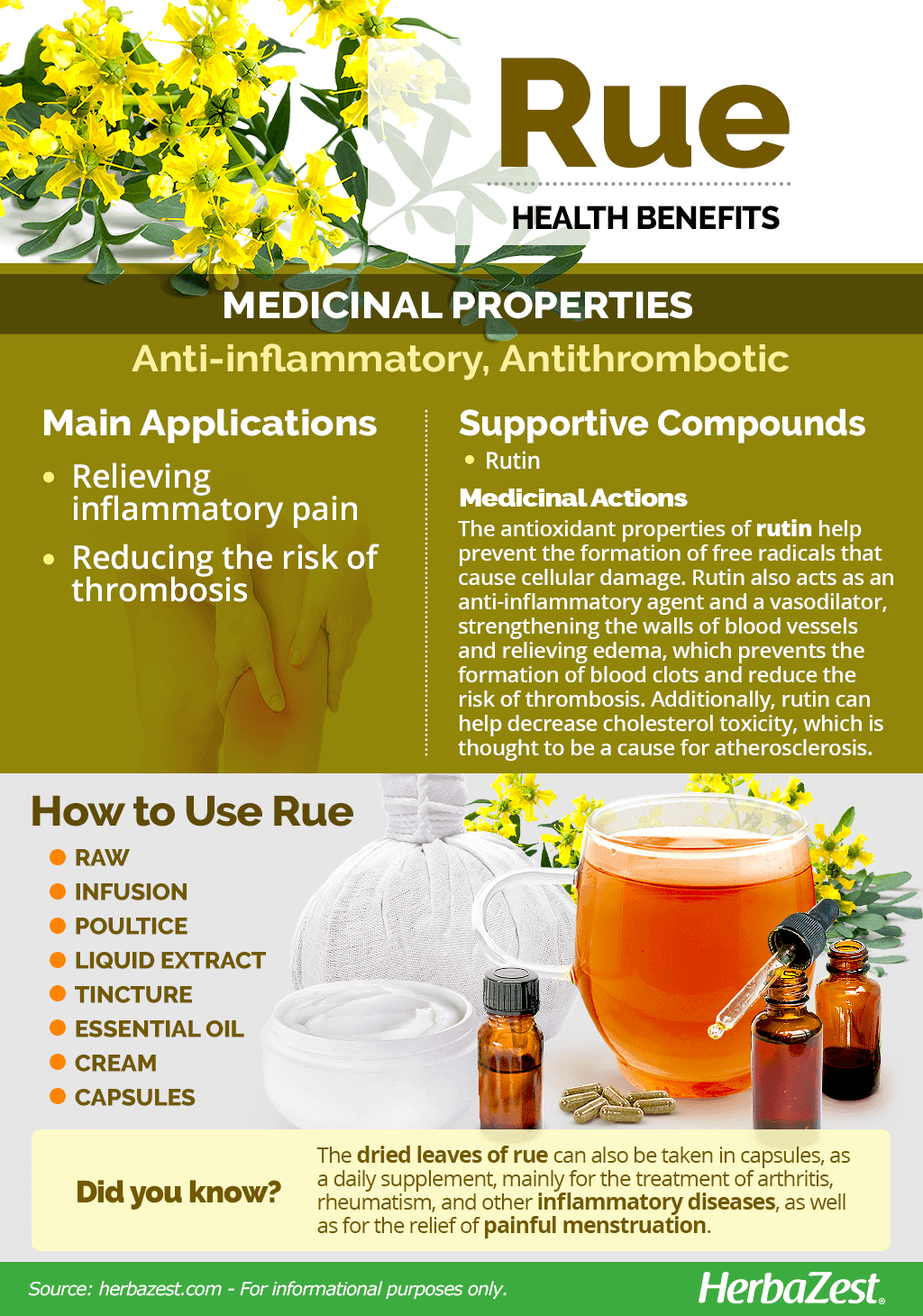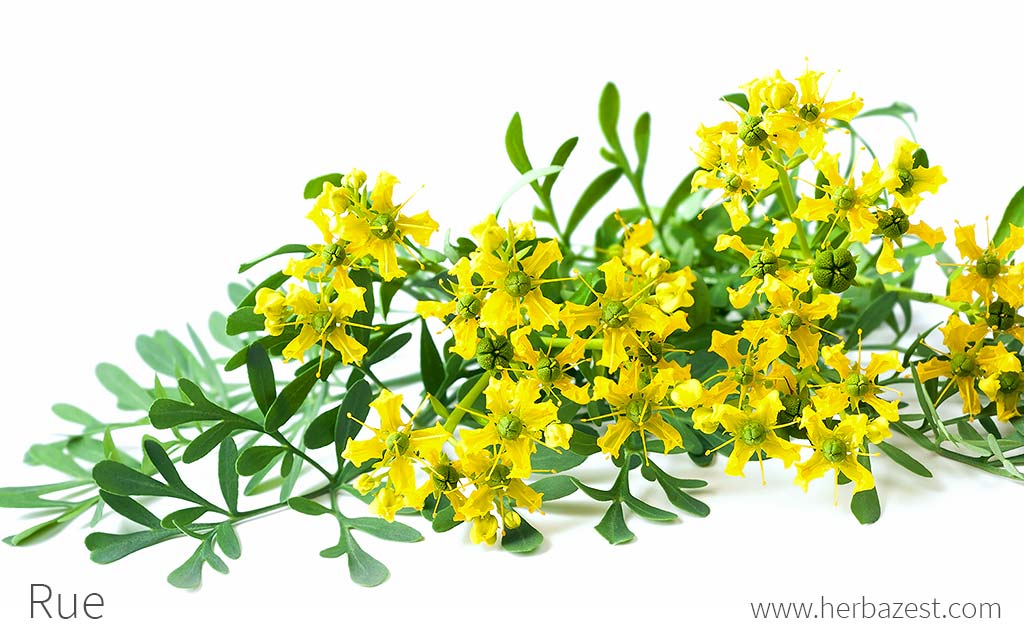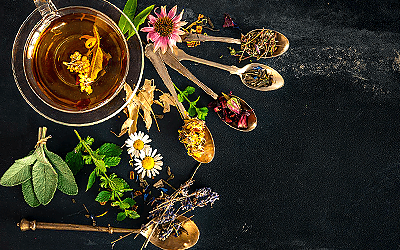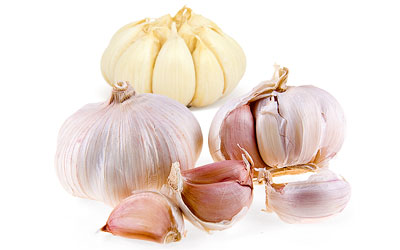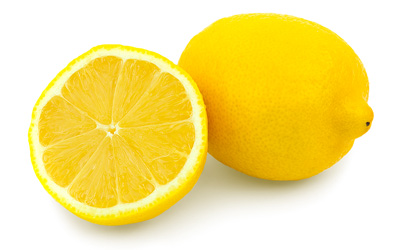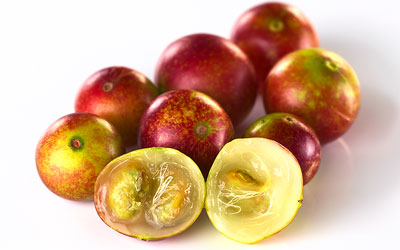Rue is a small shrub native to South Europe and North Africa. It was reportedly used in ancient Greece and Egypt for treating a wide variety of health conditions, and finally brought to the New World by Spanish explorers. Today, rue is mostly known as an ornamental and commonly found in home gardens; however, its medicinal uses are still valued by herbalists, and scientific research is discovering more potential applications for this underrated plant.
Rue Medicinal Properties
Health Benefits of Rue
Rue properties, mainly anti-inflammatory, analgesic, and cardioprotective, have a well-deserved reputation in traditional medicine, and scientific studies have corroborated some of these folk uses, such as:
Relieving inflammatory pain. Rue properties has been used for centuries to treat menstrual pain, rheumatism, arthritis and other inflammatory conditions.
Reducing the risk of thrombosis. Rue benefits blood circulation and helps prevent the formation of blood clots, strength blood vessels, lower blood pressure, and reduce edema.
Other popular applications of rue include its use as an insect repellent and antiparasitic agent.
Additionally, preliminary research suggests that rue properties may help relieve arrhythmia and improve eye health, as well as inhibit some strains of bacteria, such as Escherichia coli and Trichomonas vaginalis.
How It Works
Rue health benefits are attributed to its major active constituents, mainly flavonoids, rutin, quercetin, furocoumarin and lemonins.
Rutin -also known as rutoside- plays an important role in preventing the creation of free radicals that cause cellular damage. Besides its antioxidant properties, rutin also acts as an anti-inflammatory agent and a vasodilator, strengthening the walls of blood vessels and relieving edema, which prevents the formation of blood clots and reduce the risk of thrombosis.
Additionally, rutin can help decrease cholesterol toxicity, which is thought to be a cause for atherosclerosis.
The rue herb also contains alkaloids, vitamin K, and volatile oils, which hold anti-inflammatory, antispasmodic, analgesic, diuretic, and stimulating properties.
THE RUE HERB HAS BEEN USED FOR CENTURIES AS A NATURAL REMEDY FOR MENSTRUAL DISORDERS, SHARPENING EYESIGHT, CIRCULATORY DISORDERS, AND INDIGESTION.
Herbs well-known for their anti-inflammatory properties are turmeric and devil's claw, while ginkgo and rosemary also promote good circulation and help prevent cardiovascular diseases.
Rue Side Effects
When used topically, rue can cause allergic reactions. Reported symptoms include redness, blisters, and increased pigmentation. The consumption of this herb in any form can also increase sunlight sensitivity and risk of miscarriage, as well as further reduce low blood pressure.
It should be noted that the rue plant can be toxic if taken in high doses, so it is important to consult a doctor before consuming this herb in medicinal amounts.
Cautions
Combining rue consumption with certain drugs can alter its medicinal action. People taking medication for heart conditions, such as digoxin and Dobutrex, as well as any drugs for lowering blood pressure are advised to seek a medical opinion before consuming any form of the rue herb.
Rue can also counteract the effects of fertility drugs, and pregnant women should never ingest rue, since it can cause miscarriage.
- Medicinal action Anti-inflammatory, Antithrombotic
- Key constituents Rutin
- Ways to use Liquid extracts, Food
- Medicinal rating (1) Very minor uses
- Safety ranking Use with caution
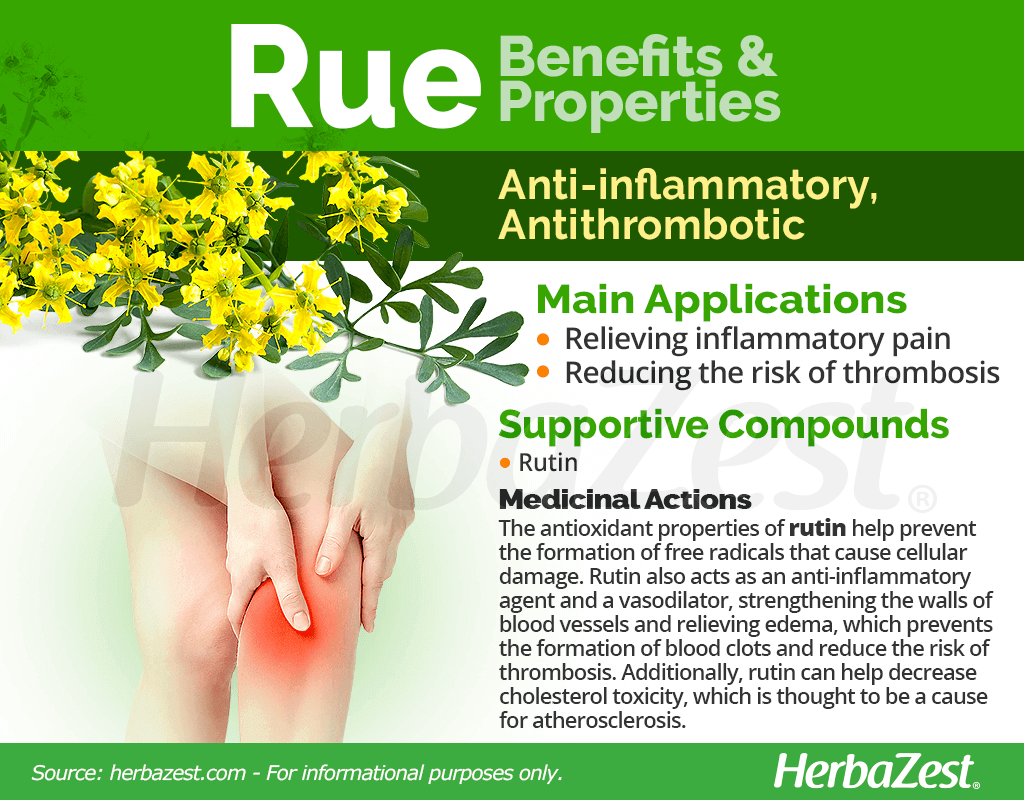
How to Consume Rue
Italians traditionally ate rue in their salads for good eyesight, and rue leaves were used to flavor Italian grape liqueur, grappa. The culinary applications of rue have declined in popularity, but the herb is still sometimes used in Ethiopian, Greek, and Italian cuisine. It is very bitter to taste, so it is usually added to sauces for flavoring.
Although not as popular as it once was, rue still provides medicinal benefits in the form of herbal remedies.
Natural Forms
Raw. The fresh leaves of rue can be applied as a skin antiseptic and a natural insect repellent.
Infusion. Both fresh and dried, the leaves of rue can be steeped in hot water and taken to relieve digestive complaints and painful menstruation.
- Poultice. The fresh leaves of rue can be crushed and applied directly in order to reduce rheumatic pain.
Herbal Remedies & Supplements
Liquid extract. This is a strong preparation that needs to be mixed with water before drinking it to relieve inflammation and encourage menstruation.
Tincture. With a base of alcohol, this is another concentrated form of rue that needs to be diluted in water.
- Essential oil. Few drops of rue's essential oil on a cotton plug cam be placed over the ear in order to relieve earaches.
Cream. In this form, rue can be applied topically for joint and muscle pain relieve.
Capsules. The dried leaves of rue can also be taken as a daily supplement, mainly for the treatment of arthritis, rheumatism, and other inflammatory diseases, as well as for the relief of painful menstruation.
- Edible uses Flavoring
- Taste Bitter
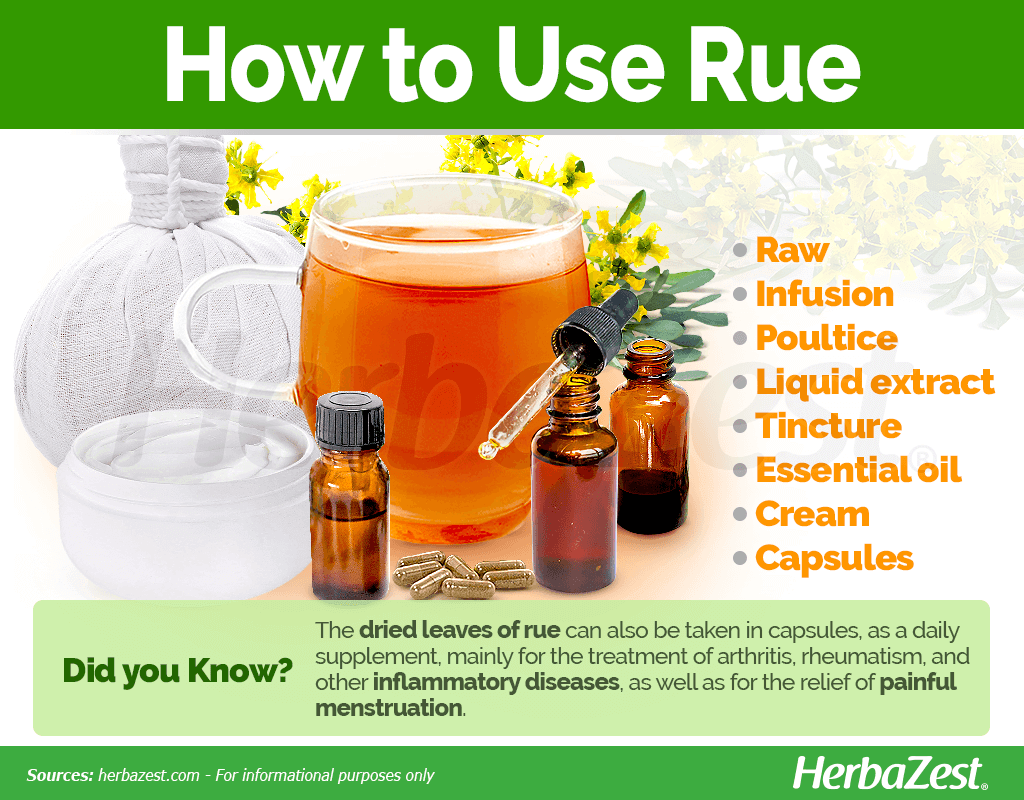
Growing
The rue plant is a hardy perennial that can thrive almost anywhere, in a wide variety of soils and climates. However, in order to grow its best, rue will require some basic care and conditions.
Growing Guidelines
The rue plant prefers full sun and dry conditions.
Rue can grow in a variety of soil types, but it prefers well-drained soil. However, it can even do well in rocky, dry soil with scarce watering and no external fertilization.
The rue herb can be propagated through both seeds and cuttings, and will require as little as 1.6 feet (0.5 m) of space between plants.
A rue plantation will provide optimum yields for up to ten years before foliage production begins to diminish.
It is recommended to wear gloves when handling the rue plant, because its sap often causes rashes and skin irritation.
- Life cycle Perennial
- Light requirements Full sun
- Growing habitat Everywhere except tundra
- Plant spacing average 0.5 m (1.64 ft)
Additional Information
Plant Biology
Rue is a woody, perennial shrub with a strong aroma that grows about three feet (1 m) in height. It has bluish-gray leaves with small, yellow flowers. Rue is considered indigenous in South Europe and North Africa, but it is now cultivated in many parts of the world.
Classification
Rue, or Ruta graveolens, is part of the Rutaceae family, which contains a wide variety of aromatic plants, which grow mainly in tropical regions. The name of rue's botanical genus, Ruta, is derived from the Greek word reuo, which means "to set free," because the herb was thought to be effective in treating diseases.
Related Species
A closely-related species, Ruta chalepenis, is also native to the Mediterranean region, and can be used to get rid of worms, promote menstrual flow, and soothe sore eyes.
Historical Information
The first records of rue medicinal and culinary uses can be traced back to ancient India and Iran, and mentions to the herb appear in various classical texts of both Ayurveda and Unani medicine.
Ancient Greeks and Romans, also held rue in high esteem. The reputed physician Dioscorides listed over a dozen topical uses for the herb, and Pliny regarded rue leaves infused in wine as a powerful antidote for fungi, snake bites, rabid dogs bites, and scorpion stings.
During the 14th century, rue was an ingredient in Four Thieves Vinegar, a beverage thought to prevent the bubonic plague. The alleged benefits of the herb were so many that Renaissance visual and plastic artists, such as Michelangelo and da Vinci, consumed rue in order to improve their vision.
Spanish explorers are believed to have introduced rue into the Americas, from where it quickly spread to the rest of the world.
Popular Beliefs
The ancient Greeks used to burn rue or take baths with the infused herb for protection against witches and evil spells. This tradition persisted during the Middle Ages and, even nowadays, rue is still believed to bring prosperity and good luck in many cultures around the world.
Another common name for rue is herb-of-grace, and comes from the Catholic tradition of using a rue brush to sprinkle holy water during the mass.
Economic Data
While rue is not the most well-known herb, it is produced and purchased for various reasons. Rue is used as a culinary additive for flavoring, as an ornamental garden plant, and for its essential oils. Rue is easily grown worldwide, so no significant industry has been developed for profit.
Other Uses
Cosmetics. Rue extract is used for fragrances, soaps and other personal care products.
Gardening. Rue is a popular ornamental, not only because of its unusual blue-gray colored leaves and bright yellow flowers, but because it repels garden pests, such as flies, mosquitoes, beetles, slugs, fleas, and cats.
- Other uses Cosmetics
Sources
- American Journal of Pharmtech Research, Ruta graveolens: from Traditional System of Medicine to Modern Pharmacology: an Overview
- Ancient Science of Life, Identity and pharmacognosy of Ruta graveolens Linn, 2012
- Boston University, School of Medicine: Ruta graveolens
- Inflammopharmacology, Methanolic extract of Ruta graveolens L. inhibits inflammation and oxidative stress in adjuvant induced model of arthritis in rats, 2009
- Medical Toxicology of Natural Substances, pp. 579-581
- Rodale's 21-Century Herbal, p. 254
- The Complete Guide To Herbal Medicines, pp. 472-473
- The Desktop Guide to Herbal Medicine, p. 80
- The University of Texas at El Paso, Herbal Safety, Rue
- The Western Herbal Tradition: 2000 Years of Medicinal Plant Knowledge, pp. 287-290
- Vaginal Antiinfectives-Advances in Research and Application: 2013, pp. 16-17
- Encyclopedia of Herbal Medicine, p. 264
- Medicinal Plants of the World, p. 280
- Germplasm Resources Information, Ruta graveolens L.
